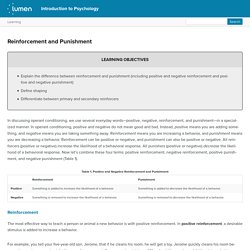

Reinforcement and Punishment. Learning Objectives Explain the difference between reinforcement and punishment (including positive and negative reinforcement and positive and negative punishment)Define shapingDifferentiate between primary and secondary reinforcers In discussing operant conditioning, we use several everyday words—positive, negative, reinforcement, and punishment—in a specialized manner.

In operant conditioning, positive and negative do not mean good and bad. Instead, positive means you are adding something, and negative means you are taking something away. Reinforcement means you are increasing a behavior, and punishment means you are decreasing a behavior. Explaination on Positive Reinforcement. Examples of Negative Reinforcement in the Workplace - Joseph Chris Partners. Positive and negative reinforcements are two common theories that managers often use in the workplace as a means to motivate employees to act.

Between the two, the latter is seen to promote positive action, but can also lead to problematic behaviors. By definition, negative reinforcement is when something that is already present, but is unwanted (negative), is removed because of someone’s actions. This will then result to a favorable outcome for that person.
Negative Reinforcement is defined as subtracting or removing a non - likeable stimulus to increase a behaviour. What is Negative Punishment (Examples and Effectiveness) In this article, we will review negative punishment, its definition, examples, and drawbacks.

American psychologist B.F. Skinner developed the theory of operant conditioning, which stated that a person or animal’s behavior could be increased or decreased by adding or removing appropriate stimuli after the behavior is exhibited. The difference between classical conditioning and operant conditioning is that classical affects unconscious behavior, while operant affects conscious behavior. Within operant, punishment aims to reduce a behavior while reinforcement increase a behavior. Punishment or reinforcement can be positive or negative. Negative Punishment. Introduction and example of Positive Punishment. 12 Examples of Positive Punishment & Negative Reinforcement. You might be thinking that “positive punishment” sounds like an oxymoron, after all, how can punishment be positive?

Not many people “like” punishment, right? The disconnect in understanding this concept comes from the usage of the word “positive;” here at PositivePsychology.com, we generally use the term “positive” to refer to things that are inherently good, things that are life-giving, and things that promote thriving and flourishing. 12 Examples of Positive Punishment & Negative Reinforcement.
Effective Vs. Counterproductive Methods Of Teen Punishment. By: Nicole Beasley Updated February 04, 2020 Medically Reviewed By: Aaron Horn Source: rawpixel.com It is important for all parents to understand what works and what doesn't when it comes to helping your children.

Tips on how parents could use Negative Punishment for teenagers. Positive Reinforcement tips for parents that could be used on their teens. BYU Study: a need for positive reinforcement among teens. There are countless publications describing the best ways to raise a child in the hopes of them becoming successful adults.

Between the books, magazines and video tutorials, parents may be finding themselves overwhelmed on more than one occasion. But a group of researchers at Brigham Young University have found the answer to helping children through life may be less complicated than it seems.